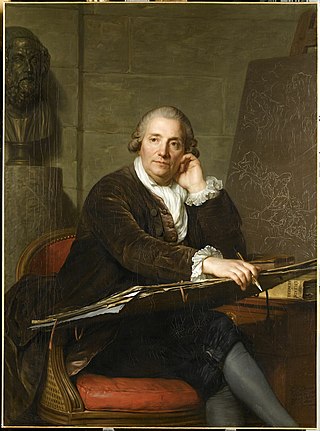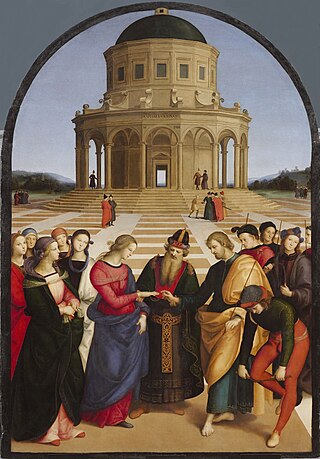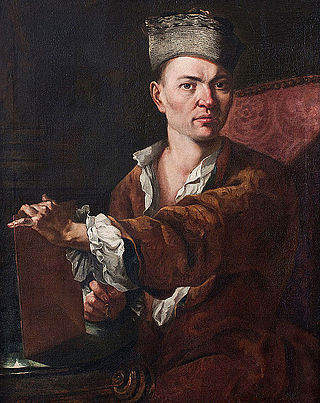

Michelangelo Unterberger, also Michael Angelo Unterberger and Michelangelo Unterperger (11 August 1695, Cavalese - 27 June 1758, Vienna) was a South Tyrolean painter in the Baroque style.


Michelangelo Unterberger, also Michael Angelo Unterberger and Michelangelo Unterperger (11 August 1695, Cavalese - 27 June 1758, Vienna) was a South Tyrolean painter in the Baroque style.
He was the son of a forest warden. His first studies were with Giuseppe Alberti in Cavalese. He completed his training with a study trip to Venice, where he worked with Nicola Grassi. [1] After that, he moved to Bolzano, where he painted a version of "The Judgment of Solomon" in the town hall and became a citizen in 1726.
In the years around 1730, he worked at various monasteries and churches in Passau and the lower Inn valley as an altar painter. [1] His paintings include a "Baptism of Christ" at Vornbach Abbey and two versions of the "Holy Family" at the chapel in Schärding and the parish church in St. Florian am Inn. Several works from this period have been lost.
In 1737, he settled permanently in Vienna, establishing himself as one of the city's leading altar painters, receiving a number of commissions from the Imperial Court. From 1751 to 1754 and again from 1757 to 1758, he was the Rector of the "Imperial and Royal Court Academy of painters, sculptors and architecture" (now the Academy of Fine Arts Vienna). [1] The title "Rector Magnificus" was originally bestowed upon him in 1751 by the Empress Maria Theresa.
Some of his best-known works in Vienna are at St. Michael's Church and the dome in St. Stephen's Cathedral. [2] Often cited as his finest work is his depiction of Saint Mary's death at Brixen Cathedral. Upon his death, his valuable collection of paintings and drawings was bequeathed to his younger brother Franz, who was also a well-known painter. [1]
In 1899, a street in Vienna's Brigittenau district was named after him.

The Academy of Fine Arts Vienna is a public art school in Vienna, Austria.

Gabriel François Doyen was a French painter of historical and mythological scenes.

Tobias Pock was an Austrian Baroque painter from Swabian descent, a pioneer of sacral art.

The St. George Cathedral, colloquially known as the Roman Catholic Dome, is the cathedral of the Roman Catholic Diocese of Timișoara and one of the city's landmarks. The cathedral is dedicated to St. George and was built between 1736 and 1774. After the Cathedral Basilica of Oradea, it is the second largest Baroque religious building in Southeastern Europe. Liturgies in Hungarian, German and Romanian are currently held regularly in the cathedral. Due to the remarkable acoustics, organ concerts are also held here.

Florentine painting or the Florentine school refers to artists in, from, or influenced by the naturalistic style developed in Florence in the 14th century, largely through the efforts of Giotto di Bondone, and in the 15th century the leading school of Western painting. Some of the best known painters of the earlier Florentine School are Fra Angelico, Botticelli, Filippo Lippi, the Ghirlandaio family, Masolino, and Masaccio.

Italian Renaissance painting is the painting of the period beginning in the late 13th century and flourishing from the early 15th to late 16th centuries, occurring in the Italian Peninsula, which was at that time divided into many political states, some independent but others controlled by external powers. The painters of Renaissance Italy, although often attached to particular courts and with loyalties to particular towns, nonetheless wandered the length and breadth of Italy, often occupying a diplomatic status and disseminating artistic and philosophical ideas.

Christopher Unterberger, also Christoph or Cristoforo was an Italian painter of the early-Neoclassical period.

Paul Troger was an Austrian painter, draughtsman, and printmaker of the late Baroque period. Troger's illusionistic ceiling paintings in fresco are notable for their dramatic vitality of movement and their palette of light colors.
Joseph Ignaz Appiani was a South-German painter of the late Baroque era. He was the son of plasterer Pietro Francesco Appiani from Porto Ceresio, and Maria Sophia from Fürstenfeldbruck. His uncle was the plasterer Jacopo Appiani (1687–1742).

Jacopo Zoboli, also known by Giacomo, was an Italian painter of the Baroque style.

Martin Knoller was an Austrian-Italian painter active in Italy who is remembered for his fresco work.

Innsbruck Cathedral, also known as the Cathedral of St. James, is an eighteenth-century Baroque cathedral of the Roman Catholic Diocese of Innsbruck in the city of Innsbruck, Austria, dedicated to the apostle Saint James, son of Zebedee. Based on designs by the architect Johann Jakob Herkomer, the cathedral was built between 1717 and 1724 on the site of a twelfth-century Romanesque church. The interior is enclosed by three domed vaults spanning the nave, and a dome with lantern above the chancel. With its lavish Baroque interior, executed in part by the Asam brothers, St. James is considered among the most important Baroque buildings in the Tyrol.
Josef Kramolín was a Czech Jesuit brother and painter. He primarily painted religious-themed frescoes.

Felix Ivo Leicher was a Czech-Austrian painter of altarpieces and secular works, which was spread to a wide area throughout the Habsburg Empire and beyond.

Cosroe Dusi was an Italian painter in the Neoclassical style, active for many years in St Petersburg, Russia, painting mainly sacred and historical subjects. Dusi was nicknamed by his contemporaries the "modern Tintoretto", for his liveliness of invention and rapidity at painting.

Ignaz Unterberger was a painter and printmaker, who was also an inventor. He lived his entire life in the Holy Roman Empire. He was a member of a large dynasty of Tyrolean artists.

Michael Angelo Immenraet (1621–1683) was a Flemish history and portrait painter who is mainly remembered for a lavish Baroque painting series of biblical scenes that he produced for the Unionskirche, Idstein in Germany.

Franz Sebald Unterberger, or Unterperger was a South Tyrolean painter in the Baroque style.
Elmar Hillebrand was a German sculptor.